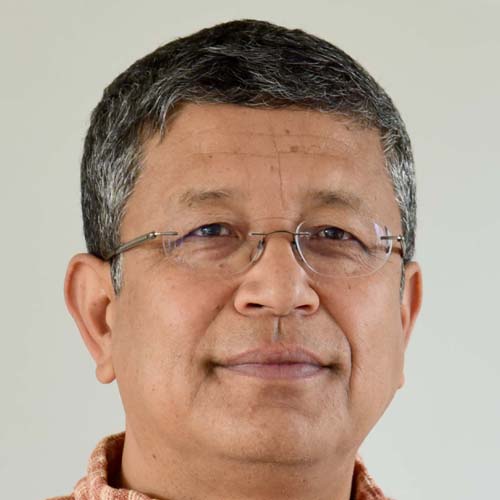Opinion
Breaking the threshold
Just the other day, I happened to hear a radio discussion on the issue of introducing a threshold in parliamentary elections.
Deepak Thapa
Just the other day, I happened to hear a radio discussion on the issue of introducing a threshold in parliamentary elections. For those who have not been completely clued in, this is a provision being debated in Parliament that would allow a party’s electoral performance to be converted into seats only if it receives a certain percentage of the national vote. Internationally, this threshold generally ranges from 2 to 5 percent and the votes of any party that fails to cross this mark are either discarded or distributed among the other parties that do. The idea is to reduce the number of parties in Parliament and avoid the intensive horse-trading that goes on with the fall of every government.
Going back to the radio programme, one of the panellists holding forth was Prem Bahadur Singh, a man of all seasons for his singular ability to be at home in any government that gives him a place. Elected a UML MP in 1999, he entered King Gyanendra’s cabinet in 2005, which seemed to be an unfortunate choice since, besides being booted out of his party, it also led him to lose his seat when the Interim Legislature-Parliament was formed in 2007. But he made a comeback in the first Constituent Assembly as the sole member representing the Samajbadi Prajatantrik Janata Party, and once more in the second Constituent Assembly with the same/different party called the Samajbadi Janata Party. He has become a minister three times since and remains one at the moment even though his party was deregistered in March 2016 by the Election Commission for not submitting its income and expenditure report. Singh’s case is also the one held up as an example of why the threshold needs to be introduced.
Big parties vs small parties
For the record, Singh’s party (or parties) garnered 0.3 and 0.2 percent of the national vote in the two elections, respectively. So it was no surprise that he was strongly against the idea of a threshold. One of his main arguments was that the threshold would be very unfair to voters since under the current system someone who receives a few hundred votes would be elected while a party getting some thousands would not be considered for a seat.
Let’s look at the extreme case of Manang, which forms the smallest electoral district in the country. The last two members from Manang received 1,652 and 1,527 votes respectively in the first-past-the-post part of the two CA elections. In contrast, Singh’s outfits received 35,752 and 21,624 in the proportional representation part. According to the new law being proposed, both the honourable members from Manang would enter Parliament but Singh would not.
On the political instability that the threshold system was supposed to do away with, Singh’s position was simple: all the making and breaking of governments have been due to the big parties—the same ones now using the instability argument. Consider the timeline below and one begins to see his point:
July 1994: Prime Minister Girija Prasad Koirala dissolves Parliament following internal dissent within Nepali Congress (NC).
November 1994: Manmohan Adhikari of UML becomes prime minister.
September 1995: Sher Bahadur Deuba of NC becomes prime minister in coalition with Rastriya Prajatantra Party (RPP) and Nepal Sadbhavana Party (NSP).
March 1997: Lokendra Bahadur Chand of RPP becomes prime minister with the
support of UML.
October 1997: RPP splits and Surya Bahadur Thapa becomes prime minister with the support of NC and NSP.
March 1998: UML splits into UML and CPN-ML, and Girija Prasad Koirala of NC becomes prime minister.
August 1998: CPN-ML joins the Koirala government.
December 1998: CPN-ML is replaced by UML in Koirala government and coalition is joined by NSP.
In the 1999 election, the NC wins an outright majority but by the time of the dissolution of Parliament in 2002, internal dissent ensures the country has seen three NC prime ministers.
Thereafter,
July 2008: Prachanda of CPN-Maoist becomes prime minister in coalition with UML, and Madhesi Janadhikar Forum Nepal (MJF-N) and others.
May 2008: Madhav Kumar Nepal of UML becomes prime minister with the support of NC and MJF-N.
June 2010: Madhav Kumar Nepal resigns. Sixteen rounds of elections are held until November without result because of the intransigence of the Maoists and the UML.
February 2011: Jhala Nath Khanal of UML becomes prime minister with the support of UCPN-M.
August 2011: Baburam Bhattarai of UCPN-M becomes prime minister.
March 2013: Chief Justice of the Supreme Court, Khil Raj Regmi, becomes prime minister.
February 2014: Sushil Koirala of NC becomes prime minister with UML in coalition.
October 2015: KP Oli of UML becomes prime minister with UCPN-M, RPP-Nepal and MJF-D.
July 2016: Pushpa Kamal Dahal Prachanda becomes prime minister in coalition with NC.
Nowhere do any of the small parties figure as kingmakers. Coalitions have been built and broken, and can only be built and broken, by the big players. The only time a ‘small’ party actually caused a government to fall was in 1995, when the NC took the support of the RPP to topple the UML and when the RPP allowed itself to break up and be manipulated into forming the government, first, by the UML, and then by the NC. But the RPP was not a small party at the time. It represented 10 percent of the House of Representatives (and 18 per cent of the national vote), not much less than the 14 percent the Maoists command in the current Parliament.
Other restraining provisions
Granted that it becomes a bit unwieldy to have 25 or 30 parties in Parliament, as was the case in the first and second CAs, but how insignificant they are (eg, the second CA has 10 parties with only one member each), they have little wriggle room unless egged on by the larger ones. The agenda is always set by the latter as we saw most vividly in the total monopoly imposed by the Big Three in the drafting of the constitution itself. In a society as diverse as Nepal’s, it becomes important for all voices to be represented no matter how weak in a body like Parliament. Had the threshold been in place, we would not have had the pride of being able to point out to Sunil Babu Pant as the first openly gay member of our national legislature.
The constitution already has a provision in place that checks the toppling of governments in that a no-confidence motion cannot be filed for the first two years of a government’s formation and a subsequent motion would have to wait for a whole year. Political scientists would argue that this rule goes against the concept of parliamentary politics itself. Perhaps better would have been to adopt the German innovation called the ‘constructive vote of no confidence’ whereby a government cannot be brought down unless an alternative can be demonstrated. But that was not to be.
There is one more reason why the Big Three should reconsider introducing the threshold. Remember the Seven-Party Alliance (SPA), the one that signed the November 2005 agreement with the Maoists and got a mention in the Interim Constitution. The SPA claimed legitimacy from the fact that together they represented 95 per cent of the seats in the 1999 Parliament. But of the seven, the two factions of the NC and the UML alone had 89 per cent of the seats. One of the seven did not have any MPs but none of the other three would have made the 3 percent threshold had it been in place, and neither would they even now. But, the SPA certainly sounded better than a TPA (three-party alliance). I think there is a moral issue involved here as well.




 19.12°C Kathmandu
19.12°C Kathmandu











